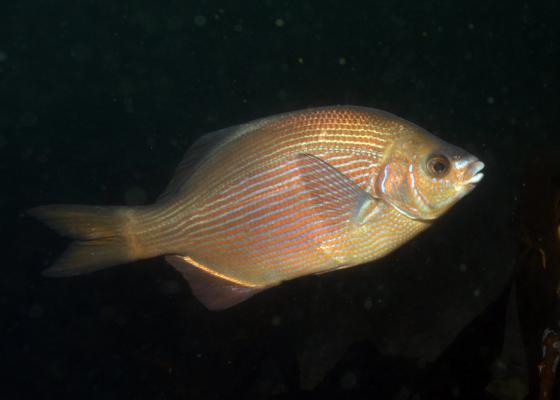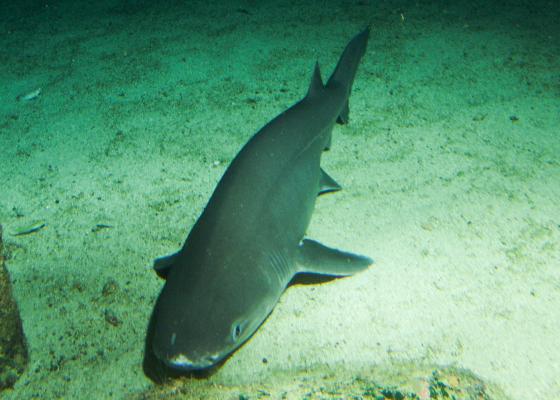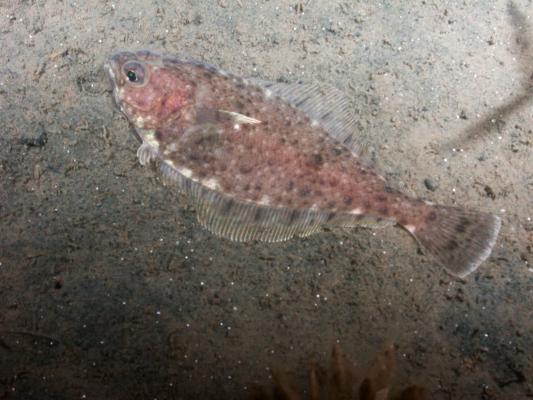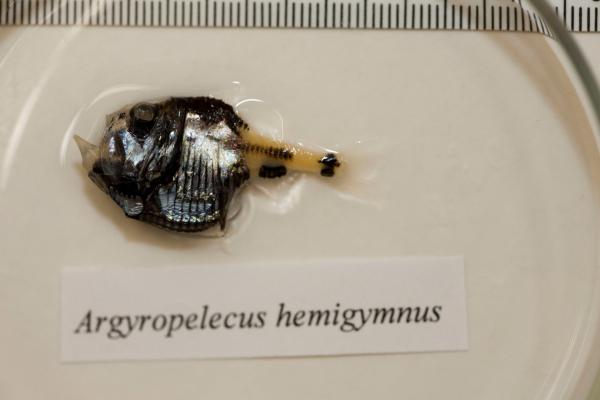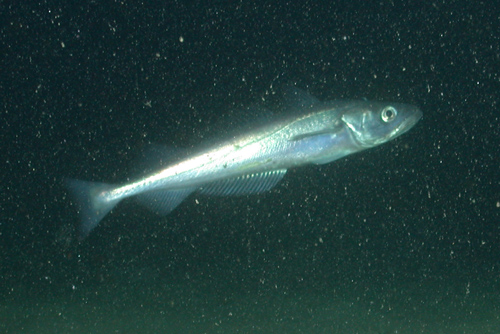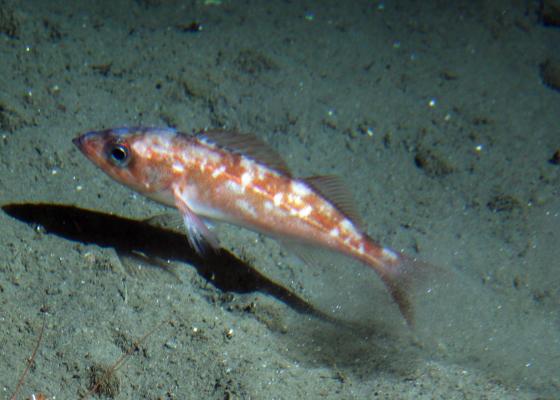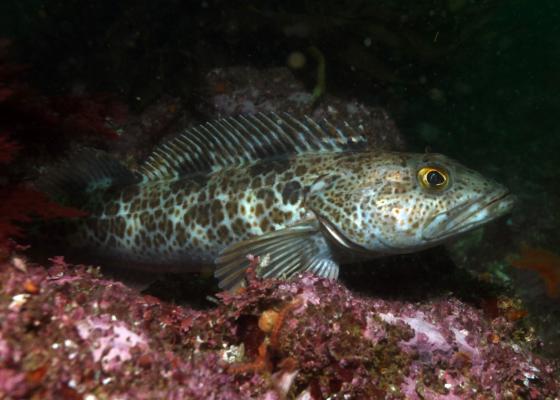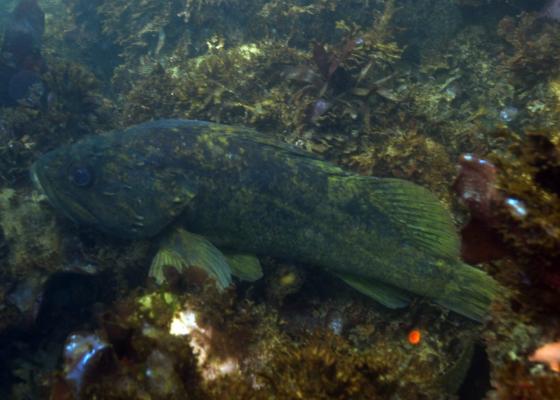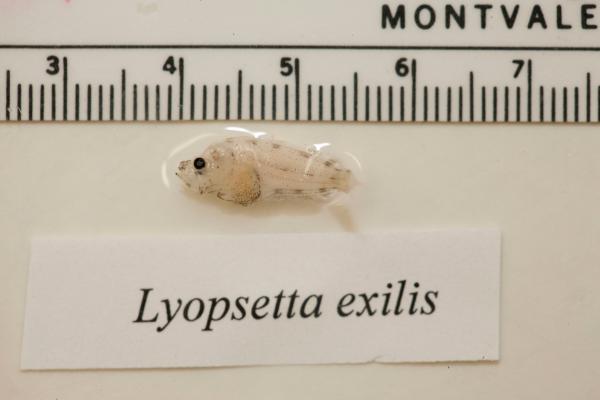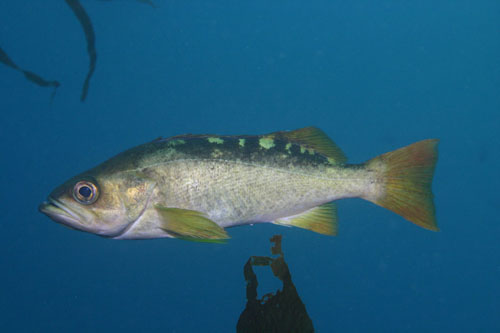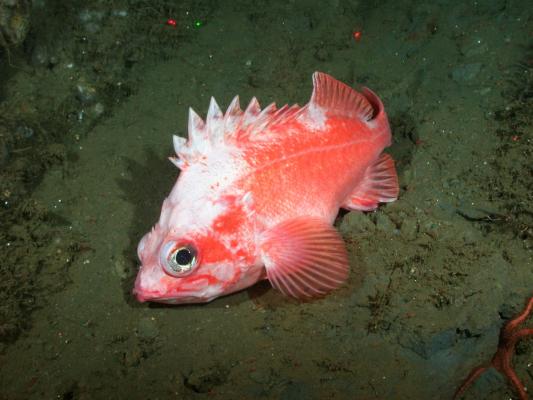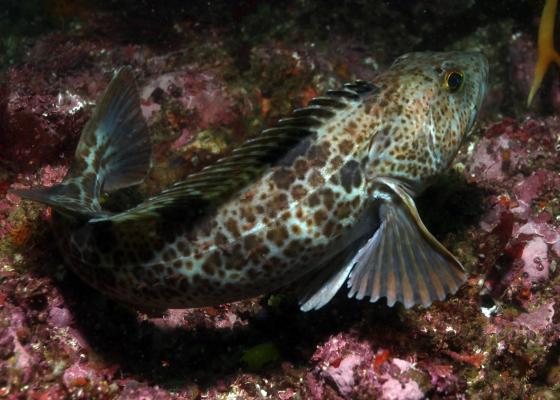Overview
The fish fauna in the Monterey Bay National Marine Sanctuary constitute a diverse and significant ecological resource. There are at least 525 fish species distributed across a wide variety of habitats in the sanctuary, with each habitat having its own characteristic fish assemblage.
The sanctuary is located at the southern end of the range of many species that are part of the very diverse, cold-temperate fauna that make up the Oregonian province. Occasionally, southern species from the California Province (south of Point Conception) extend their ranges to central and northern California during warm oceanographic events, such as El Niño and the Pacific Decadal Oscillation.
Conservation and management issues affecting fishes in the sanctuary include fisheries, habitat loss and alteration, productivity, and oceanographic conditions.
- Fisheries: The diverse fisheries in central California are part of the region’s rich cultural and economic history. The sanctuary does not currently manage commercial or recreational fisheries; the Pacific Fishery Management Council and California Department of Fish and Game manage federal and state fisheries, respectively.
- Habitat: Trends for two habitat types, where similar species groups are caught, can be described:
- Soft-bottom deep-shelf and soft-bottom slope are the two most prevalent habitats in the sanctuary. They contain mud and silty sediments and a large number of invertebrate species. A combination of regulations (for rockfishes and flatfishes) and environmental conditions (affecting Pacific Ocean shrimp and Dungeness crab recruitment) led to a recent decline in catch in this habitat group.
- Semipelagic rockfishes are the primary component of catches in rocky deep-shelf and rocky slope habitats. These habitats are usually characterized by high-relief rock pinnacles, boulders or walls. Overall commercial catch trends within the sanctuary (1981 to 2000) of all species from rocky deep-shelf and rocky slope habitats reflect the general declining population trend of many rockfishes. Visit here for more information on the trends of fishes caught.
Habitat loss and alteration from human activities is of special concern. Some habitats are critical for certain life stages of species, such as spawning or rearing. The habitats in this region that are most threatened include estuaries and coastal wetlands, eelgrass and kelp beds, and rocky bottoms.
- Productivity and Oceanographic Conditions: Many organisms, including some fishes, depend on ocean currents for larval dispersal and recruitment. Therefore, the variability of oceanographic features and events (e.g., upwelling, El Niño), affects fish populations. Rockfishes (genus Sebastes), for example, exhibit extreme variability in reproductive success.
Monitoring
A number of scientists in this region are working on monitoring programs to study fishes in the various sanctuary habitats. These programs include monitoring the natural variation of fish abundance in kelp forests; studying the influence of tidal exchange on the fishes in Elkhorn Slough; characterizing groundfishes in deep, rocky-shelf habitats; and surveying the distribution and abundance of pelagic juvenile young-of-the-year rockfishes.
Some of these programs are described below.
The Influence of Varying Tidal Exchange on the Fish and Crab Assemblages of Elkhorn Slough
Scientists from Elkhorn Slough National Estuarine Research Reserve and UC Santa Cruz investigated how assemblage structure and species distribution and abundance patterns of fishes and crabs are influenced by variation in tidal flow and freshwater input throughout shallow-water habitats in the Elkhorn Slough estuary.
Fish and crab abundance patterns were surveyed throughout 18 locations in Elkhorn Slough that fall into one of three categories: full tidal flow, muted tidal flow and very muted tidal flow/seasonally high freshwater input. Fish and crab abundance patterns varied across habitat types and across seasons, depending upon which species were considered. The very muted/seasonally high freshwater input sites were most different in terms of species composition and abundance patterns compared to the other two flow regimes, but there were also differences between the full and the muted flow sites in regards to these factors.
Long-term Monitoring of Groundfishes in the Monterey Bay National Marine Sanctuary
In 2004, scientists from California Sea Grant, California Academy of Sciences, NOAA Fisheries, Moss Landing Marine Laboratories and the sanctuary surveyed deep, rocky continental shelf habitats to characterize, monitor and assess long-term changes in benthic fishes and associated habitats. They conducted 131 visual strip transects aboard the submersible Delta to compare groundfish abundance, size and diversity off Monterey Peninsula and Point Sur from 70 to 120 meters.
Overall species diversity, abundance and sizes were greater off Point Sur than off the Monterey Peninsula. Off the Monterey Peninsula, the deeper (70 to 90 meters) high-relief rocky areas had lower species diversity than the shallower (90 to 120 meters) low-relief areas.
The scientists also revisited sites off Monterey Peninsula that were surveyed in 1993 and compared abundance, species-habitat relationships, and species and size composition. Species composition was relatively similar. Mean lengths of all rockfishes were greater in 2004 than in 1993, except for yellowtail rockfish, Sebastes flavidus, and squarespot rockfish, Sebastes hopkinsi.
Trends in Fisheries and Fishery Resources
A recent study by scientists at California Sea Grant and Moss Landing Marine Laboratories summarized trends in fisheries and fishery resources associated with the sanctuary from 1981 to 2000.
More than 200 invertebrate and fish species are commercially or recreationally harvested from sanctuary waters, with the bulk of the commercial landings composed of squid, rockfishes, salmon, albacore, Dover sole, sablefish, mackerel, anchovy and sardines. A decline in commercial landings at sanctuary ports from 1981 to 2000 was directly related to reduced population sizes of many of the species inhabiting deep-water bottom habitats, caused by excessively high rates of fishing in the 1980s, when fishery scientists and resource managers overestimated the productivity of bottom fish stocks.
From 1990 to 2000, catches of many fishery resources greatly declined, due both to decreases in fish populations and to new regulations enacted to conserve or rebuild fish stocks.
Mid-Water Trawl Pre-Recruit Survey
The productivity of rockfish (genus Sebastes) fisheries depends almost exclusively on the occurrence and influx of strong year classes. Sound management of these fisheries, therefore, requires accurate information on impending recruitment.
YOY rockfish catches showed a large degree of temporal variability. In addition, the temporal patterns were similar among many of the different rockfish species. Catches were generally large during the 1980s but dropped substantially during the 1990s, with the exception of 1991 and 1993.
During May and June every year since 1983, the NOAA NMFS SWFSC Fisheries Ecology Division has performed an annual survey of the distribution and abundance of pelagic juvenile young-of-the-year (YOY) rockfishes aboard the NOAA Ship David Starr Jordan.
The poor catches during the 1990s could be attributed to the generally warm conditions during that time period as well as the occurrence of strong El Niño and La Niña conditions, which adversely affect rockfish recruitment. Generally cooler ocean conditions began to develop beginning in 2000, and YOY rockfish catches increased substantially from the very low catches of 1998 (an El Niño year), with large numbers collected during 2002 and 2004. However, since 2004, catches north of Point Conception have been very low. In 2005, in the area south of Point Conception, catches of YOY rockfish were extremely high, indicating significant environmental/ecological differences between the regions north and south of Point Conception.
Photos
Maps
Projects
1978 - 1998 DFG Fishery-independent Hook-and-line Fishing Surveys Along Central California Coast
The California Department of Fish and Game's Central California Marine Sport Fish Survey (Refugia Project) conducted fishery-independent hook-and-line fishing surveys along the central California coast in nearshore waters, adjacent to kelp beds and over rocky reefs, from 1978 to 1998.
Application of molecular genetic methods to rockfish predation and habitat association research efforts in Central California
This study used previously developed genetic methods to enhance ongoing research projects in the Monterey Bay National Marine Sanctuary by identifying unknown rockfish (Sebastes spp.) samples to the species level.Archival of Midwater and Benthic Survey Data at Moss Landing Marine Laboratories
Since the early 1970s, faculty and students in Marine Ecology, Invertebrate Zoology, and Ichthyology courses at Moss Landing Marine Laboratories (MLML) have participated in class cruises aboard several research vessels to survey the fishes and invertebrates in shallow-benthic, deep-benthic and midwater habitats in Monterey Bay.California Collaborative Fisheries Research Project: Surveys of Nearshore Fishes in and near Central California Marine Protected Areas
This project involved the fishing communities of Half Moon Bay, Monterey Bay, Morro Bay, and Port San Luis, California to develop monitoring protocols for the use of hook and line fishing gear. Baseline data were collected for three Marine Protected Areas that were established by the State of California in September 2007. Experienced volunteer anglers fished with standardized gear for a specified amount of time while aboard one of five Commercial Passenger Fishing Vessels (CPFV), landing a total of 7,928 fishes, comprised of 27 species. Fishes were identified, measured, tagged, and released.California Cooperative Oceanic Fisheries Investigations (CalCOFI)
The California Cooperative Oceanic Fisheries Investigations (CalCOFI) was formed in 1949 to study the ecological aspects of the Pacific sardine population collapse off California. Today, the focus has shifted to the study of the marine environment off the coast of California, the management of its living resources, and monitoring the indicators of El Nino and climate change.
Carmel River Steelhead Count
By using an automatic fish counter at San Clemente Dam, the Monterey Peninsula Water Management District has monitored the Carmel River steelhead population since 1991.Characterization of Salinas Watershed Stream Habitat & Fish Species Composition
The primary objective of this project was to examine fish species distribution and to quantitatively evaluate physical habitat quality throughout the Salinas Watershed.Coastal Ecology of Juvenile Salmonids in California
The goal of this study is to determine the abundance, distribution, growth, and health of juvenile salmonid stocks (chinook salmon, Oncorhynchus tshawytscha, coho salmon, Oncorhynchus kisutch, and steelhead, Oncorhynchus mykiss) and the influences of environmental factors on the central California coast.Cooperative Research and Assessment of Nearshore Ecosystems (CRANE)
The Cooperative Research and Assessment of Nearshore Ecosystems (CRANE) program was established in spring 2003. CRANE uses quantitative diver visual surveys to sample kelp forests for fishes, invertebrates, and algae.Davidson Seamount 2015: Characterization of Mammals, Birds, and Midwater Fishes Above and Adjacent to Davidson Seamount
This multi-disciplined and complex research mission accomplished most of the research goals for areas within the Davidson Seamount Management Zone and other Sanctuary Ecologically Significant Areas (SESAs). The NOAA fishing survey vessel, "Bell M. Shimada" was used as the operational platform. Individual projects completed included the recording of marine mammal and ocean noise with hydrophones, oceanographic data and water sampling with a CTD, collection of water samples for Fukushima isotope analysis (with a CTD), collection of water samples for environmental DNA analysis (with a CTD), mesopelagic fish surveys (with a tucker trawl), marine mammal and seabird surveys were conducted above and adjacent to Davidson Seamount (although most of the surveys occurred in a Beaufort state 6 or above, making the data incomprable), and filming for video production of NOAA research and collaborative Marine Biodiversity Observatory Network (MBON) was completed. Additional proposed research that could not be completed due to ocean conditions included Puma drone surveys to observe marine mammals at DSMZ. Media Day was held off the wharf in Santa Cruz.Delineation of Critical Inshore Spawning Grounds for Commercially Valuable Squid Fisheries on the East and West Coast of the USA
This project proposes to use the best available acoustic sampling technology (hardware, software, and sampling routines) to find and measure the areas of greatest concentration of benthic egg beds of the squids Loligo opalescens.Ecology and Population Dynamics of White Sharks in the Eastern Pacific: a Case Study
White sharks (Carcharodon carcharias) have been flagged for international protection, yet effective population assessments and management actions have remained hindered by lack of knowledge about the geographical extent and size of distinct populations. Combining satellite tagging, passive acoustic monitoring, visual mark recapture, genetic and stable isotopic analysis we aim to determine white shark critical habitat, migratory patterns foraging ecology and population structure.Juvenile Rockfish Abundance Surveys using SCUBA
Scuba surveys are conducted by the National Marine Fisheries Service (NMFS) throughout late spring and summer to count the number of juvenile rockfish of all species that settle to the kelp bed and nearshore environments. An annual index is produced from this data for each species.Long-term Monitoring of Groundfishes in the Monterey Bay National Marine Sanctuary
Because many populations of fish and invertebrates are declining, we are developing a long-term monitoring plan to assess changes of benthic fishes and macroinvertebrates in the in the Monterey Bay National Marine Sanctuary. Initially we conducted submersible to survey groundfishes in selected deep rocky continental shelf and slope habitats of the sanctuary.Mark and Recapture Studies of Nearshore Groundfishes in the Carmel Bay Area
This project collects information to support fisheries management and to provide baseline information for the purpose of evaluating marine protected area (MPA) efficacy for marine resources in the Monterey Bay region. A commercial passenger fishing vessel was used as a platform to hook-and-line catch and tag fishes at the Carmel Pinnacles State Marine Reserve and a nearby, non-protected site at Carmel Point. Tagged, recaptured fishes inform managers on nearshore groundfish populations, movement, and species composition in the Carmel Bay region.REEF (Reef Environmental Education Foundation) monitoring program
The Reef Environmental Education Foundation (REEF)'s Fish Survey Project enlists the help of recreational SCUBA divers to identify and count nearshore fishes.
Rockfish recruitment and ecosystem assessment surveys
The NOAA National Marine Fisheries Service (NMFS) Southwest Fisheries Science Center (SWFSC) Fisheries Ecology Division has conducted annual surveys of the distribution and abundance of pre-recruit stage rockfish as well as other commercially important species such as Pacific whiting in order to provide year-class strength information that can be used in the fisheries management process. Hydgrographic conditions present during the surveys are also examined.Tagging of Pacific Predators (TOPP)
The Tagging of Pacific Pelagics (TOPP) research program aims to understand the migration patterns of large predators in the North Pacific basin and how these animals act and interact in their open ocean habitats. By using satellite tagging techniques, TOPP researchers follow the movements of different species across multiple trophic levels (i.e., the food web) and in relation to physical oceanographic features in order to piece together a whole ecosystem picture.Links
American Fisheries Society
Strives to advance fisheries and aquatic science and promote the development of fisheries professionals.http://www.fisheries.org
CalCOFI: California Cooperative Oceanic Fisheries Investigation
Learn about a partnership between government agencies and institutions to investigate the California state fisheries.http://www.calcofi.org/
California Department of Fish and Wildlife
Manages California's diverse fish, wildlife, and plant resources, and habitats for ecological value and public use.http://www.dfg.ca.gov/
FishBase
Search for fish in a database of over 25,000 species, see photos and more.http://www.fishbase.org/search.html
Fisheries Economics Data Program
A cooperative fisheries economics data collection program.http://www.psmfc.org/efin/index.html
MARE: Marine Activities, Resources and Education
MARE is an interdisciplinary science program at the Lawrence Hall of Science (UC Berkeley) offering year-round professional development opportunities, including events that immerse your whole school—faculty, students and families—in the study and celebration of the ocean.http://www.lawrencehallofscience.org/MARE/
MARE: Marine Activities, Resources and Education - "Build A Fish" Interactive Activity
Fun flash game where user can build a fish by choosing mouth, body and tail, then see how well it would survive in a given habitat. Also provides links to other resources.http://sv.berkeley.edu/showcase/flash/fish.html
MBARI - Deep-Sea Guide
A web-based system that allows for the correlation of visual, descriptive, and observational data with environmental data from multiple sources by providing tools for searching, identifying, and examining occurrence data (e.g., depth, time, abundance) for biological, geological, and experimental observations.http://dsg.mbari.org/
Monterey Bay Aquarium - Student and Teacher Resources and Activities
The Monterey Bay Aquarium offers teacher and student resources including: species and habitat-specific information, live cams, classroom activities, and interactive online games.http://www.mbayaq.org/lc/
Monterey Bay National Marine Sanctuary - Anadromous Fishes
A comprehensive and educational scientific characterization of anadromous fishes in the Monterey Bay Sanctuary.http://montereybay.noaa.gov/sitechar/fish.html
National Marine Fisheries Service
Promotes maintenance of sustainable fisheries, recovery of species and protects habitats.http://www.nmfs.noaa.gov
NOAA - Online Teaching Materials
Topics covered include El Niño, storms, the atmosphere, fisheries, the oceans and more. Each unit contains background information, data, applications, and additional activities and is written for middle school level.http://www.oar.noaa.gov/k12/index.html
NOAA Photo Library
NOAA's photo library contains incredible shots of an amazing array of animals, technology, scientists, and images of historical treasures. Site also offers search function for images.http://www.photolib.noaa.gov
Pacific Coast Fisheries Information Network
The Pacific Fisheries Information Network (PacFIN) is the nation's first regional fisheries data network. Funded by a grant from the National Marine Fisheries Service (NMFS), PacFIN is a joint federal and state project focused on fisheries data collection and information management. PacFIN provides timely and accurate data to aid effective management of fisheries and fishery resources.http://pacfin.psmfc.org/
Pacific Coast Salmon Fisheries Activities
Offers activities related to salmon habitat, conservation and technology.http://collections.ic.gc.ca/pacificfisheries/teacher/kids.html
Pacific Fisheries Management Council
Responsible for the management of west coast federal fisheries.http://www.pcouncil.org
Pacific States Marine Fisheries Commission
An interstate commission dedicated to resolving fisheries issueshttp://www.psmfc.org
Recreational Fisheries Information Network
Provides info on recreational landings by area.http://www.recfin.org
Tagging of Pacific Predators: near real-time animal tracks
Images of near real-time satellite tracking data of pelagic species of sharks, mammals, and turtles.http://topp.org/
Texas A&M University and Jason Education Project - Ocean World Activities
Ocean World lesson plans and classroom activities. Associated with each of the background information sections are five classroom activities built on the common themes of: systems and structures, energy, change, interactions, and measurement. These classroom activities are intended to be a starting off point to tailor to a class.http://oceanworld.tamu.edu/educators/lesson_activities.htm
The Bridge - Ocean Sciences Teacher Resource Center
Materials and curricula related to many areas of study in the Monterey Bay. Be sure to check the data tip of the month archives. (Supported by the National Sea Grant Office, the National Oceanographic Partnership Program, and the National Marine Educators Association.)http://www.vims.edu/bridge/
The Great Annual Fish Count
An annual event each July to introduce divers and snorkelers to the hobby of fishwatching and to educate the public about marine resources.http://www.fishcount.org/
The Great Annual Fish Count
An annual event each July to introduce divers and snorkelers to the hobby of fishwatching and to educate the public about marine resources.http://www.fishcount.org
The Pacific Shark Research Center (PSRC) at Moss Landing Marine Laboratories
The PSRC at MLML conducts both basic and applied scientific research on the biology of Pacific Ocean chondrichthyans, serves as a resource center for scientific information on sharks to public policy makers, and participates in collaborative research on national and international issues involving shark, ray, and chimaera biology.http://psrc.mlml.calstate.edu/
